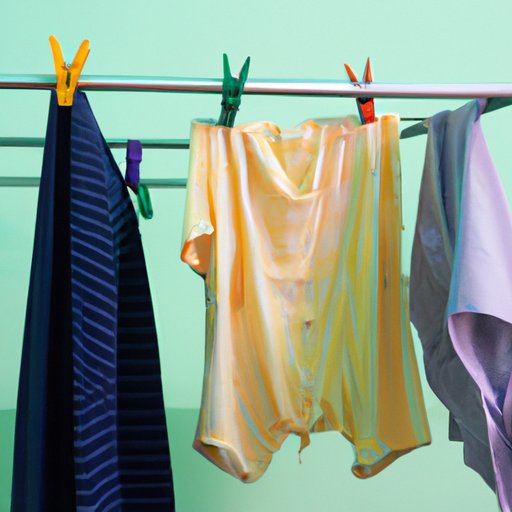
I. Introduction
When it comes to doing laundry, most of us want to get the job done as quickly and efficiently as possible. This has led some people to wonder whether it’s okay to dry whites and colors together, rather than taking the time to separate them. In this article, we’ll explore the pros and cons of drying whites and colors together, as well as provide tips for keeping your clothes looking their best. Whether you’re a busy parent, a student on a budget, or just someone looking for ways to streamline your laundry routine, this article is intended to help you make an informed decision.
II. Pros and Cons of Drying Whites and Colors Together
Drying whites and colors together can certainly save time and energy. It’s more convenient than separating your clothes, which can take up valuable time and energy. Plus, if you’re short on space, you may not have the luxury of having separate drying areas for whites and colors. However, there are some potential problems that could arise. Whites can become gray or yellowed, while colors can fade and bleed.
One argument in favor of drying whites and colors together is that modern laundry detergents and machines are designed to handle mixed loads. Additionally, if you’re washing and drying clothes that aren’t prone to bleeding or fading, it may be fine to do so. Alternatively, you can test a small patch of each garment to see if any bleeding or fading occurs before committing to drying a large load.
III. Tips for Keeping Your Clothes Looking Their Best
Regardless of whether you choose to dry whites and colors together, there are some tips you should follow to keep your clothes looking their best. For whites, consider using a pre-treatment on any stains before washing, using a whitening detergent, and avoiding chlorine bleach that can damage fabrics. If you’re washing colors, always read clothing labels for specific washing instructions, turn clothes inside-out to reduce friction, and use a fabric softener to help keep colors bright.
When it comes to drying your clothes, remove them from the dryer as soon as the cycle is finished to avoid any wrinkles. Consider hanging clothes on a drying rack, which can be more gentle on fabrics than a dryer. For clothes that must be put in the dryer, use a low heat setting and set the timer to avoid over-drying and causing damage to the fibers.
IV. Common Laundry Mistakes and How to Avoid Them
One of the most common laundry mistakes is mixing whites and colors together in the wash, as well as in the dryer. Not only can this lead to discoloration, but it can also cause clothes to wear out faster due to the different wash and dry cycles required. Additionally, using too much detergent, not emptying the lint trap, and using hot water when cold will do can cause shrinkage and damage fabrics. Always take the time to review clothing labels and follow manufacturer’s care instructions to avoid these common laundry faux pas.
V. How to Save Time and Money When Doing Laundry
Drying whites and colors together can be a way to save time, energy, and ultimately money. By streamlining your laundry routine, you can reduce the amount of time and energy required to do multiple loads. Additionally, using a drying rack or air drying clothes can reduce energy consumption. By using less energy, you’ll see a lower utility bill and ultimately save money.
VI. How to Minimize Environmental Impact When Doing Laundry
If you’re looking to minimize your environmental impact, there are several measures you can take. By combining whites and colors in the wash, you’ll be able to save water and energy resources. Additionally, you can choose a more eco-friendly detergent that’s free of harsh chemicals and use less fabric softener to reduce chemical pollution. By air-drying clothes, you’ll further save energy, conserving resources and reducing greenhouse gas emissions.
VII. Conclusion
Drying whites and colors together is a personal decision that depends on your unique laundry needs. While there are some potential downsides, it can be a practical solution for those short on time and space. Ultimately, it’s important to take steps to keep your clothes looking their best, whether you’re separating your loads or drying them together. Following manufacturer’s care instructions, using less energy, and being mindful of your environmental impact can all go a long way in maintaining a sustainable and efficient laundry routine.





